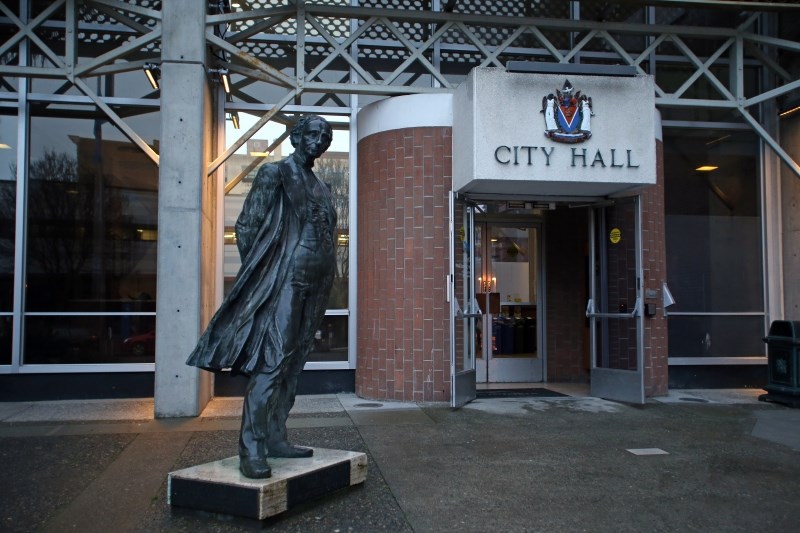It’s been in the works for years, but when Victoria’s new stormwater utility bills recently started arriving in mailboxes, many residents were caught unaware — forcing the city to deal with a flood of calls and emails.
“I assure you that the city has been working as hard as we can to make sure we have people available to answer questions,” said Fraser Work, the city’s director of engineering and public works.
The city says the switch to a user-pay system for stormwater management is cost neutral. The portion of property taxes (about $4.5 million) the city used to fund stormwater services was removed from the tax bill last year, and property owners are instead being billed directly according to the size and nature of their property.
“There’s no double billing here,” Work said. “It was taken off the property taxes and now we’re rolling it into its own bill.”
Mayor Lisa Helps said the new system is more equitable.
“The rationale behind it is to make it fair, so it’s a user-based system,” Helps said, citing the example of provincially owned properties, on which no city property taxes are paid. Now, instead of “everybody else subsidizing the stormwater usage of the province,” the province will receive a utility bill, she said.
Another example, she said, is commercial parking lots, which will be paying a more proportionate share of stormwater costs.
“The idea is to incentivize people to create more permeable surfaces on their property to help the water go directly back into the earth and not into the storm drains,” Helps said.
Stormwater is rain that lands on hard surfaces and flows into drains and pipes. The stormwater system helps manage rain and runoff, reducing flooding by moving excess stormwater away from properties, and separates some oil, metals and soil from the water. It includes about 250 kilometres of underground storm drain pipes, as well as catch basins and outlets.
The new billing system takes into consideration factors such as size, property and street type, and the amount of hard areas such as driveways and parking lots.
“The old model, which was pay for [stormwater] on your property tax based on your assessed value, made much less sense,” Work said. “I think it’s a much better system — but it’s a complex system.”
One thing that is clear is not everyone is happy about receiving yet another bill from the city.
Coun. Geoff Young said he never anticipated that the stormwater bill would be issued separately from either property taxes or other utility bills.
Young said he supports the underlying principle that a property such as a parking lot, which puts a higher demand on the system, should pay more than one that is undeveloped.
“That said, there’s certainly some suspicion that the city is using it as a way of disguising other property tax increases, and there is certainly grumbling about city expenditures overall,” he said.
The Canadian Taxpayers Federation has long been critical of municipalities shifting the property tax burden to utilities.
Jordan Bateman, the federation’s B.C. director, noted a stormwater utility differs from other utilities because usage cannot be directly metered and billed.
He suggested bills are sent out at “completely the opposite time of property tax time specifically to try to trick people into thinking that they are paying less property taxes than they really are.”
Helps bristled at the suggestion that the new utility is a tax grab or a shell game tactic.
“That is absolutely untrue. Every single cent that is flowing into the stormwater utility bill is taken out of property taxes,” Helps said. “It’s fair, it’s rational, and it’s very forward-looking.”
Work said the city may want to re-evaluate its decision to keep the stormwater bill separate from other utilities.
He said much of the discussion on how to bill for stormwater occurred prior to his tenure.
“I think we wanted to keep it as a standalone because it was new, because it was unique in a way, and rolling it in with something else might confuse people even more.”
What is stormwater?
Stormwater is rain that lands on hard surfaces then flows into drains and pipes. The stormwater system helps to manage rain and runoff, reducing flooding by moving excess stormwater away from properties. It also separates some of the oil, metals, sand and soil that would otherwise flow into our waterways and ocean.
How are stormwater charges determined?
The City of Victoria’s stormwater utility charges are based on several elements:
• Property type — Properties are identified as low density residential (one to four units), multifamily residential (five more more units), commercial/industrial, or civic/institutional.
• Impervious area — The amount of hard surfaces such as roofs, parking areas and driveways on the property. Rainwater flows off these areas and is diverted into the stormwater system.
• Street cleaning — Keeping streets clean goes a long way to keeping stormwater clean. The amount is determined by the length of the property’s street frontage and the street type.
• Intensity code — The impact a property has on the stormwater system, based on the property type as determined by B.C. Assessment.
• Codes of Practice Program — This is a program to clean stormwater before it leaves a property. Properties will be registered in the program if they have 10 or more parking spaces, are automotive businesses, recreation facilities, recycling operations, storage yards or have construction activities onsite.
• Rainwater Rewards (credit) — Financial incentives are offered for sustainable rainwater management, including rain gardens, cisterns and permeable (absorbent) paved areas.
For more information, go to victoria.ca/stormwater.
Source: City of Victoria



